Newsfront (1978) – Phillip Noyce So I came into this course with an open mind, intending to be flexible with my reception of Australian cinema and television. There is a good chance this attitude may have stemmed from a slightly guilty conscious about my lack of involvement and participation in our national film industry. But having said that, when I watched Newsfront, I could appreciate it, but still did not enjoy it very much. I compliment the characterisation and the acting within in the film which I relished, but found the episodic structure of the film and the loose ends within the narrative a bit harder to handle. One of the main points of this for me personally surrounded the character of Bryan Brown, Geoff. I was quite intrigued by his character who then it appeared suddenly up and left for England after one short conversation with a fellow employee about it. As an audience member, I personally prefer at least some sort of closure for endings, and even for smaller conclusions within the narrative. It also puzzled me how the theme associated with Newsfront for this week was Americanization and I don’t quite see how Geoff’s fleeing to England played a significant role in the storyline, particularly when the temptation was supposed to be America which was juxtaposed with the main character, Bill Hunter’s Len Maguire, and represented him as being old fashioned (at least in comparison to America and its advanced technology and modernity). I thought the main obstacle for the industry within the film was more to do with the introduction of television and its consolidation of market share, not so much the lure of America. Although when the two news reel companies were in competition and one ‘going international’ was seen as superior, we are lead to believe that the remaining company still had relative success whilst marketing itself as the only pure ‘true’ Australian news company. All these differences between the two alternatives comes to a head when Len is going into the boss’ office with his letter of resignation because he was offered a job in the US with his brother, but then changes his mind when offered a large national task.
Within any Australian film we see the stereotypical characteristics portrayed in different ways, subtly or not, and Newsfront is no exception. It is with this exact scenario we see evidence of Len’s loyalty, not only to his company and colleges, but also to his country, when in the final scene he argues with his own brother about keeping the footage in Australia and not sending it overseas to America even when offered a significant and tempting amount of money. I appreciate the fact that he represents an attempt not to ‘sell out’ to Hollywood and America in general, but I did feel that television as a technological innovation was a larger problem for the companies than the threat of the American industry.
After thinking about Gallipoli and other Australian films I have come to somewhat of a conclusion:
I think the thing I like the most about Australian films is that I generally walk away from them feeling somewhat fulfilled and left with a sense of national pride. This may be because the directors incorporate techniques to pull distinct strings within the audience. But personally I think it’s more about what I identify as being characteristically Australian, recognising it within a film and its characters, therefore forging a greater connection with the film. And then comes the overwhelming feeling of relief and pride when Australian characters prevail through use of characteristics like mateship, loyalty, practicality, bravery and sometimes even anti-authoritarianism.
I’ve also realised the pride I feel when anything Australian is recognised on an international scale, particularly within the film industry, such as directors, cinematographers, animators, actors and even the films themselves. I’m not sure if this comes from a national subconsciousness of inferiority in relation to other countries, which is definitely possible, or just because I like to boast and take ownership of particular films and people, “oh, thats David Wenham! I love him! He's an Aussie!”.
Gallipoli – Peter Weir (1981) Gallipoli (1981), Peter Weir, is a distinctly Australian film in many regards: form, style, narrative and characterisation. All of these notions revolve around significantly Australian ideals and myths and may be the reason why the film had such an impact on the Australian audience. The characters within the film represent varying Australian traits, predominantly those associated with the ANZAC legend (masculinity, competitiveness, mateship, larrikin, belief in the ‘fair go’, anti-British/anti-authoritarianism/anti-colonialism, a loss of innocence and pride in the nation). Particular examples of these include the competitiveness of betting and the AFL games played at the training camp in Egypt and whilst also there we see Mel Gibson’s character Frank exercise his anti-British stance by imitating one of the higher British officers, just prior to him exercising the Australian attitude of the ‘fair go’ when they take back an artefact one of his mates got ripped off on.
The film also plays up to particular structures, including the coming of age and rite of passage narratives. This can mainly be seen through Archie’s (Mark Lee) transformation throughout the duration of the film. We see him physically and emotionally change from a boy into a man. And it can even be said that the modification of Frank’s attitude is a similar type of transformation.
One aspect of the characterisation I found most interesting was the way the two best mates, Archie and Frank, were so similar in some regards but were relatively juxtaposed in terms of their differences. The key here being Archie representing the Australian bushman, and Frank as the manifestation of the Australian urban dweller. The main thing this brought to my attention was how the stereotypical Australian characteristics were evident in both men, but it felt like they were just slightly different takes on the stereotypes, solely because they were from diverse contexts. And whilst some parts of their personalities differed, I think that is what made them such good mates throughout the experiences, as well as what gave the film the emotional power it held with the audience.
Ten Canoes - Rolf de Heer (2006) The tone of Ten Canoes, not something one would normally associate with Indigenous Australian cinema, was very refreshing to see and lays a large basis for discussion on a variety of topics. One that stuck out particularly for me, was the use of the Indigenous language throughout the entire film, with only the narration in English, this technique is not something that would normally be expected in what is technically an Australian film, primarily because we are an English speaking country. The use of this native dialect also aids the authentic feel of the film, where it even borders on the impression of a documentary. One of the other aspects of Ten Canoes that borders on the realm of documentary was the shots and use of the landscape. Obviously the landscape has always been an extremely prevalent concept in Australian film, television and narratives, and Ten Canoes was no exception. The opening sequence shows some incredibly beautiful bird’s eye views of Australia’s native outback landscape, which then situates the audience into the context of the film. As it centres around an indigenous population, the film is constantly surrounded by the notions of the native landscape, which is inherently considered an ‘Australian’ concept, but is also an integral part of the indigenous way of life.
But the thing I probably enjoyed most about Ten Canoes was the fact that there was no interaction with ‘whites’ in the film, which aided the feel that the film was a genuine indigenous story. It was uplifting not to have to see conflict between the whites and indigenous communities, but just to get consumed into a purely indigenous story. Although I admit I have a lack of knowledge and experience with Australian films, I must say that I haven’t seen or heard of a film quite like Ten Canoes, and I think that is why I enjoyed it so much. It was very aesthetically pleasing, had a narrative to keep the audience interested and the characterisation was commendable. This probably has something to do with the fact that the indigenous Australians in the film were not actors, but real indigenous communities, making the film, once again, all that much more genuine. And this complete authenticity in itself, I find is hard to locate in most Australian films.
|
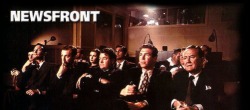



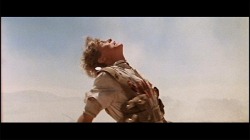
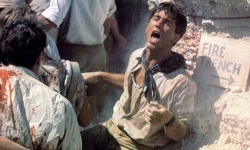
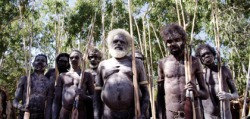
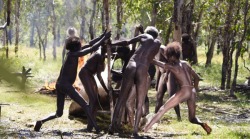
 RSS Feed
RSS Feed